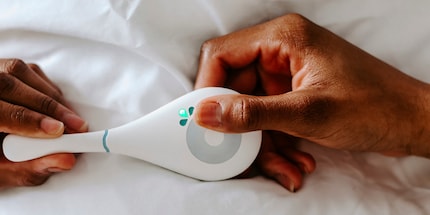
Background information
The Marie Project: How tiny bacteria affect our vaginal health
by Natalie Hemengül

Women have it up to here with hormonal contraception. Or so it seems. I’ve been coming across natural family planning methods a lot lately – also online in the shape of paid influencer advertising. I’m sceptical and ask an expert.
With broad smiles on their faces, they point period trackers, computers, apps and fertility thermometers towards the camera. Young female influencers who talk about their positive experiences with so-called natural birth control. These paid ads make me wary. Although I share the influencers’ enthusiasm for hormone-free contraception, I’d rather not get information from «Sponsored Contents». Instead, I spoke to the gynaecologist Dr Mariele Keller to find out how risky this method is and who it’s suitable for.
Dr Keller, how do natural family planning methods work?
Dr Mariele Keller, specialist FMH for gynaecology and obstetrics:
Natural birth control is based on a woman’s menstrual cycle and its fertile and less fertile days. Basically, it’s about abstaining from sexual practices that come with a risk of pregnancy during the fertile days or using barrier methods including condoms or diaphragms. The average menstrual cycle is 28 days. Women are fertile on five to seven of these days. The challenge lies in pinpointing the fertile and infertile days. Another factor that needs to be considered in the calculation is the lifespan and fertility of sperm that can last up to five days.
Is the expression «natural family planning» the same thing as the «symptothermal method»?
I’d use natural family planning as the umbrella term. It covers many methods that vary in the way the fertile days are determined. The symptothermal method is the best and the safest. It combines the observation of the morning body temperature, also called basal body temperature, and that of the cervical mucus. Another one is the Billings method. It relies on the observation of cervical mucus. Some women only pay attention to changes in their body temperature. An extremely unsafe method is the «Knaus-Ogino method», which calculates the fertile days based on the length of the menstrual cycle.
What role to basal body temperature and the observation of cervical mucus play in the symptothermal method?
In the second half of the menstrual cycle, so after ovulation, the basal body temperature is two to five tenths of a Celsius degree higher than in the first half. The method involves taking your body temperature first thing every morning with a clinical thermometer. The result is then entered in a physical chart by hand or in a respective app. Temperature measurements are oral, vaginal or rectal.
Raised body temperature on three consecutive days is a sign of ovulation. This is followed by infertile days, during which there is no need to use additional contraception. It’s much harder to determine the infertile days before ovulation. The safest option is to limit yourselves to the days following ovulation to go without contraception. Only women with a very regular menstrual cycle can calculate the days in the first half of their cycle on which unprotected sex is possible.
The symptothermal method also includes observing the cervical mucus at the opening of the vagina or cervix. This is because it changes around the time of ovulation. Around that time of their cycle, many women find the amount of vaginal discharge increases and has an elasticity to it and can be stretched between their fingers. This consistency makes it easier for sperm to enter. Before and after ovulation, the mucus is thicker and creates a natural barrier. Observing your discharge makes the body temperature method that much safer, as it’s a further indicator to determine ovulation.
In your opinion, is natural birth control equally suited to either prevent or promote a pregnancy?
As natural family planning is based on identifying fertile and infertile days, the method can be used as a form of contraception or to plan a pregnancy. While you’re abstaining from sex on fertile days in one case, you’re purposely having sex in the other.
Which Pearl index does natural birth control have and how does it compare to other hormone-free methods of contraception?
It’s hard to measure natural birth control by means of the Pearl index. Its reliability very much depends on how precisely and thoroughly a method is applied. If the execution is textbook perfect, the Pearl index of the symptothermal method is 0.4. But if it’s a mediocre application of the method, you’re looking at 1.8. To put things into perspective: the Pearl index of a condom that is used properly is 2. However, an average application will drive this number up to 12. With a Pearl index of 0.3 to 0.8, the copper coil is the most efficient hormone-free birth control method.

How reliable are fertility calculators compared to assessing which time of the month you're currently in?
Apps or fertility trackers make it easier to enter temperature curves and mucus observations. However, they’re no substitute for being well versed in the method, taking responsibility for the interpretation of the data and being critical.
Who is natural birth control suitable for in your opinion?
It’s a method that’s well suited for women with a stable and regular menstrual cycle. It also requires a partner who’s prepared to share the responsibility by using barrier methods or altogether avoiding sex practices that promote a pregnancy on fertile days. Ideally, you should be in a stable relationship in which both partners are disciplined and willing to learn about bodily processes over a longer period of time.
Are there circumstances in life that might negatively affect natural birth control?
The method is not suitable for women who have just given birth, are going through puberty or the menopause, have very irregular menstrual cycles or rarely ovulate. It’s also not recommended for women with very irregular life rhythms due to shift work, very short nights or lots of travel, for example. Stress or illnesses can lead to menstrual cycle disorders and incorrect assessments.
What are the advantages of natural contraception?
One of the clear advantages is that women are more in tune with their bodies. Provided that there’s no unwanted pregnancy, of course, the method has no side effects and is very affordable if you’re not using a fertility tracker.
What about risks?
In my opinion, the greatest risk lies in being too generous when it comes to determining the infertile days and thereby bringing on an unwanted pregnancy. A sensible training period should be around three months, which corresponds to three cycles. Admittedly, that’s a long time, but it’s realistic. The method can also put a strain on a relationship because it’s never entirely clear if and when ovulation has occurred. What’s extremely important to keep in mind is that the symptothermal method doesn’t offer protection against sexually transmitted diseases.
From a doctor’s perspective, do you also get the impression that the topic is becoming more popular or is this limited to my bubble?
I’ve noticed that my patients are generally more interested in hormone-free contraception. Especially the demand for the copper coil has risen. More and more women feel that a daily hormone intake makes them feel controlled. This goes hand in hand with many side effects including a depressed mood, loss of libido, weight gain and loss of identity. Women are definitely more interested in learning about their bodies. A typical target group for the method are women in a stable relationship and planning to start a family in the short- or midterm or those who have suffered from the side effects of hormonal contraception.
What should women look out for who want to switch to natural birth control?
Although the Internet offers a lot of information, it doesn’t replace a personal consultation with your gynaecologist. Sharing information with other committed users of this method can also prove helpful and provide support.
As a massive Disney fan, I see the world through rose-tinted glasses. I worship series from the 90s and consider mermaids a religion. When I’m not dancing in glitter rain, I’m either hanging out at pyjama parties or sitting at my make-up table. P.S. I love you, bacon, garlic and onions.
Interesting facts about products, behind-the-scenes looks at manufacturers and deep-dives on interesting people.
Show all